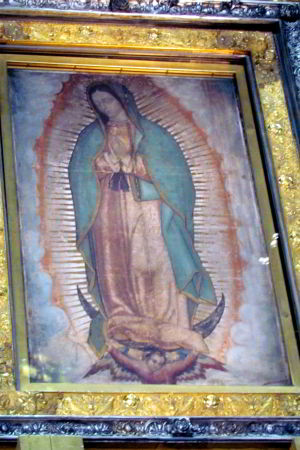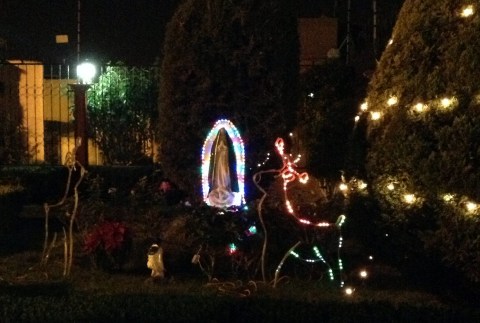Which Virgin Mary? More on the 12th of December in Mexico.
What’s the biggest holiday of the year in Mexico? Well, the Days of the Dead might make it into the top two. But #1 is probably today – El DÃa de Nuestra Señora de Guadalupe, or the Day of Our Lady of Guadalupe.
I’ve written about this day before, but it might be helpful to give a little background. I would guess that most people who are not Roman Catholic would have some questions about who “Our Lady of Guadalupe” is, and even some Roman Catholics would raise an eyebrow at what people believe here in Mexico.
The Virgin of Guadalupe is believed to be a manifestation of Mary – yes, Jesus’ mother, Mary.
Of course Mary was a real person, the virgin mother of Jesus, as the Bible teaches. But Roman Catholics believe some very specific things about Mary.
Rome has called certain beliefs de fide dogmas. This is, as I understand it, the highest level of dogma. All are bound to believe these things, and if you don’t, you’re a heretic.
Some of these beliefs include the fact that God is perfect, and that Jesus rose from the dead.
Here are some of the de fide dogmas concerning Mary:
- The Immaculate Conception: No, this doesn’t refer to the conception of Jesus, but Mary’s conception. She was conceived without original sin, says Rome. This is a religious holiday on the 8th of December. Though not de fide dogmas, the Roman Catholic Catechism also teaches that Mary never sinned during her whole life.
- Mary was still a virgin after the birth of Christ – that is, “Mary bore her Son without any violation of her virginal integrity.” How exactly this occurred is a matter of debate.
- Perpetual virginity: Mary remained a virgin her whole life. Jesus was her only son.
- The Assumption: No, this doesn’t refer to Jesus either. Mary was assumed body and soul at the end of her life. This doesn’t mean that she didn’t die – some believe that she died “voluntarily”. (Remember, Roman Catholics must believe she was sinless – and if sinless, why die?)
Just to clarify, I’m not suggesting I agree with the above – just saying what the Roman Catholic doctrine is. Remember, these are all binding beliefs – Rome believes you are outside the church – a heretic – if you disagree with any point.
The Roman Catholic Catechism gives more insight into Roman Catholic beliefs regarding Mary. Teachings include that she is the “supreme model” of faith. She’s the “New Eve” – “death came by Eve, life by Mary”. She is the Mother of the Church, and the church is to look to her, because “in her the church is already holy”. Mary is the Mediatrix of all graces – that is, mediator. Many in the Roman Catholic church consider her to be co-mediatrix or co-redemptrix with Christ.
And in Mexico?
 |
Mexico City could probably be called the World Capital of Mariology. As the story goes, Mary appeared as the Virgin of Guadalupe to a native by the name of Juan Diego. This was the 12th of December 1531. She left an imprint of her image on his cloak – and that cloak can still be seen today at the Basilica in Mexico City.
This image of Guadalupe was raised when the cry for independence went out in 1810. Guadalupe has been associated with Mexico (although veneration of her has spread across borders to many countries) since the beginning. In many (most?) Mexican’s minds, to be Mexican is to adore the Virgin of Guadalupe.
One reason why Pope John Paul II was so popular in Mexico was because of his famous attachment to this Roman Catholic Mary.
You can read more specifically about the Virgin of Guadalupe here, including a common prayer to her.
And now, millions of people who have walked, cycled, driven, etc, from all over Mexico, will arrive at the Basilica in Mexico City. They will ask her for healing, for success, for forgiveness, for favour. They will bring objects to have them blessed. They will crawl until their knees are bloody to find acceptance.
You can read more pilgrim prayers here.
Beliefs in Mary in Mexico have become mixed with ancient native beliefs and other beliefs from around the world.

Statue of the Virgin of Guadalupe on our street (almost every neighbourhood has one). The cloth mantle and lights were added for the season. You can see a small statue of Juan Diego bowing in front. The reindeer – inexplicable.
But when all is said and done, for many Mexicans Guadalupe is the perfect mother who will get things done, who cares, and who can get her son to do things (even when, perhaps, he doesn’t really want to). Where Jesus is a helpless baby in a manger or a victim on a cross, Guadalupe is the glorious triumphant mother of the faithful, who receives the glory, honour, and attention in general.
So the pilgrims will stream down the streets of our city, the rockets will go off, the celebrations will take place. And we will pray for the people of Mexico. That they would realize that the work has already been accomplished – by Jesus the triumphant Saviour, Priest and Mediator.
Notes: A lot of the information above was taken from the Catecismo de la Iglesia Catolica (2nd edition). I also referred to Fundamentals of Catholic Dogma by Dr. Ludwig Ott as quoted here. I refer to “Rome” and “Roman Catholic” because these are acceptable terms and they differentiate from “Catholic” – a word for the Universal church, of which Protestants would consider themselves a part.

12 December 2012 @ 4:23 am
This prompts me to wonder how many extra-biblical dogmas I’m clinging to. I can’t think of any, but maybe that’s because I’m so convinced. Huh. Amazing that these traditions have survived as fundamentals for so many centuries.
12 December 2012 @ 5:12 am
I don’t think there’s any doubt that we all hold views that aren’t Biblical, which is why it’s so important to keep going back to the Bible. I should note that these traditions didn’t exactly “survive as fundamentals” for centuries. These are things that developed over time. For example, the immaculate conception was proclaimed as a dogma in 1854, and the assumption in 1950.
12 December 2012 @ 5:57 am
Oh. That makes it even stranger (and less excusable) to my mind.